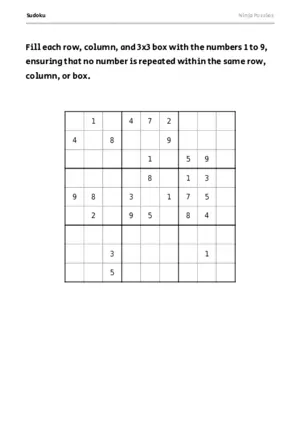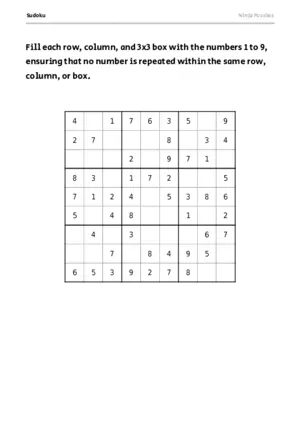Sudoku: Backtracking Strategy and Techniques
Backtracking is a common technique used in solving Sudoku puzzles when other strategies fail. It involves making educated guesses, checking for contradictions, and backtracking when necessary. Here’s an example of how you can use the Backtracking technique to solve a Sudoku puzzle:
- Begin by selecting an empty square in the puzzle grid.
- Make an educated guess by assigning a candidate number to the selected square based on the current state of the puzzle.
- Check if the assigned number violates any Sudoku rules, such as duplicating a number in the same row, column, or box.
- If a contradiction is found, go back to the previous square where the guess was made and try a different number.
- If no contradiction occurs, continue solving the puzzle using other strategies and techniques.
- Repeat steps 1-5 until all squares are filled and the puzzle is solved or until all possible guesses lead to contradictions.
Remember that Backtracking involves systematically exploring different possibilities until a valid solution is found. It may require multiple backtracks and trial-and-error before reaching a solution.
To effectively use Backtracking, it’s recommended to combine it with other logical deductions and advanced solving techniques. These techniques help reduce the need for extensive guessing and backtracking.
With practice and patience, you can become proficient at using Backtracking to solve even challenging Sudoku puzzles that seem unsolvable using logic alone.
Sudoku Solver
If you get really stuck then we have an online Sudoku Solver, and a Sudoku Mini Solver to help you solve the most challenging Sudoku puzzles.
Advanced Sudoku Strategies
- Singleton Technique: This strategy involves identifying squares that have only one possible candidate number based on the numbers already present in the row, column, and box.
- Naked Pairs and Triples: When two or three squares in a unit (row, column, or box) have the same two or three candidate numbers, those numbers can be eliminated as possibilities from other squares in the unit.
- Hidden Pairs and Triples: This strategy focuses on identifying two or three candidate numbers that only appear in the same two or three squares within a unit. These numbers can then be eliminated as possibilities from other squares in the unit.
- Sudoku X-Wing: Sudoku X-Wing involves finding two rows or two columns where the same number can only occur in the same two positions. By eliminating that number as a possibility in the corresponding rows or columns, you can make further deductions.
- Swordfish: Similar to Sudoku X-Wing, Swordfish strategy expands the concept to three rows or three columns. It involves finding three rows or three columns where the same number can only occur in the same three positions, allowing for further eliminations.
- Sudoku Y-Wing: Sudoku Y-Wing is an advanced strategy that involves three cells and three numbers. By utilizing a specific pattern of candidate numbers, you can make deductions that lead to solving other squares.
- Sudoku XYZ-Wing: XYZ-Wing involves three cells and three numbers, with each number belonging to a different candidate list. It allows for deductions by creating chains of eliminations based on the relationships between the three numbers.
- Coloring: This strategy involves assigning colors (usually two) to candidates and using the relationships between these colors to make deductions.
- Backtracking: Backtracking is a brute-force technique that involves making educated guesses and trying different possibilities until a contradiction is reached or the puzzle is solved.








